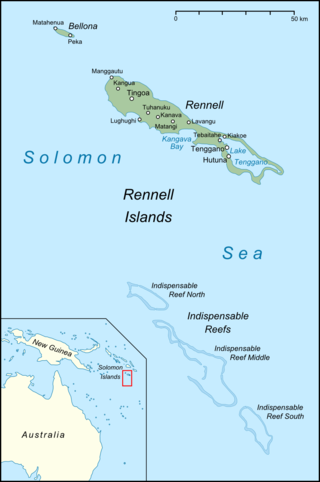Related Research Articles

Solomon Islands is an island country in the South Pacific Ocean, that lies east of Papua New Guinea.

USS Thompson (DD-305), a Clemson-class destroyer of the U.S. Navy named in honor of Secretary of the Navy Richard W. Thompson (1809–1900), never saw action against an enemy. She was the first Navy ship of that name; the second, Thompson (DD-627), named for Robert M. Thompson, served during World War II and the Korean War.

Solomon Islands is a country consisting of six major islands and over 900 smaller islands in Oceania, to the northeast of Australia. It has a land area of 28,400 square kilometres (11,000 sq mi), and a population of approximately 700,000. Its capital, Honiara, is located on the largest island, Guadalcanal. The country takes its name from the wider area of the Solomon Islands (archipelago), which is a collection of Melanesian islands that also includes the Autonomous Region of Bougainville, but excludes the Santa Cruz Islands.

Álvaro de Mendaña y Neira was a Spanish navigator and explorer, best known for two of the earliest recorded expeditions across the Pacific in 1567 and 1595. His voyages led to the discovery of the Marquesas, Cook Islands and Solomons among other archipelagos. Born in Congosto, in El Bierzo Region (León), he was the nephew of Lope García de Castro, viceroy of Peru.

Santa Isabel Island is the longest in Solomon Islands, the third largest in terms of surface area, and the largest in the group of islands in Isabel Province.

Murakumo was the fifth of twenty-four Fubuki-class destroyers, built for the Imperial Japanese Navy following World War I. When introduced into service, these ships were the most powerful destroyers in the world. They served as first-line destroyers through the 1930s, and remained formidable weapons systems well into the Pacific War.

The Chesterfield Islands are a French archipelago of New Caledonia located in the Coral Sea, 550 km (300 nmi) northwest of Grande Terre, the main island of New Caledonia. The archipelago is 120 km long and 70 km broad, made up of 11 uninhabited islets and many reefs. The land area of the islands is less than 10 km2.

The Archdiocese of Honiara is a Latin Church ecclesiastical territory or archdiocese of the Catholic Church in the Solomon Islands. It is the successor of the apostolic prefecture of the British Solomon Islands, which was erected in 1897. The ecclesiastical province of Honiara was created in 1978, the first such creation of Pope John Paul II, and contains two suffragan sees: Gizo and Auki (1982).
San Jorge Island is the second largest island in the Isabel Province, Solomon Islands.

The Indispensable Reefs are a chain of three large coral atolls in the Coral Sea. They are located about 50 km (30 mi) south of Rennell Island, separated from it by Rennel Trough. The chain stretches over a length of 114 km (71 mi) and its average width is 18 km (11 mi).
The Solomons Temple Islands are an uninhabited Canadian arctic islands group located within the midsection of James Bay in Nunavut, Canada. They are situated north of Charlton Island, and southwest of Paint Hills Islands, Pointe au Huard and Andrew Moar Bay,

Rekata Bay, also known as Suavanau, is a bay located on the northeast coast of Santa Isabel Island in the Solomon Islands between Santa Isabel and Papatura Island.
Atlas was built in Souths Shields by Temple and launched in 1801 for Temple. She made two voyages transporting convicts from Ireland or England to Port Jackson. On the first voyage she carried cargo for the British East India Company (EIC). On the second she sailed to Bengal after delivering her convicts to New South Wales and was wrecked off India in 1820 while on her way back to Britain.

Kamaosi Village is a small village in the south eastern end of Santa Isabel Island, Isabel Province, Solomon Islands. It is close to Gululu. It contains one of the two high schools on the island, Sir Dudley Tuti College.

Jerry of the Islands: A True Dog Story is a novel by American writer Jack London. Jerry of the Islands was initially published in 1917 and is one of the last works by Jack London. The novel is set on the island of Malaita, a part of the Solomon Islands archipelago, which in 1893 became a British protectorate. The hero of the novel is Irish terrier Jerry, who was a brother of dog named Michael, about whom London wrote another novel—Michael, Brother of Jerry.
Mahige is a small islet in Isabel Province of the Solomon Islands. The islet is located off the south-east tip of Santa Isabel Island.

Solomon Islands–Spain relations include the bilateral and diplomatic relations between these two countries. Solomon Islands does not have an embassy resident in Spain but maintains an honorary consulate in Madrid.
References
- "CIA World Factbook: Solomon Islands" . Retrieved 2006-05-25.
- Tideschart.com tide table of Thousand Ships Bay
- Tide-Forecast.com tide table of Thousand Ships Bay
- Hammond World Travel Atlas. Union, N.J.: Hammond World Atlas Corporation, c. 2004–2005. ISBN 0-8437-1982-6. Page 245.
- Pacific Wrecks (2009). "Santa Isabel Province". Solomon Islands. Pacific Wrecks.org. Archived from the original on December 3, 2008. Retrieved April 28, 2009.
8°25′S159°40′E / 8.417°S 159.667°E